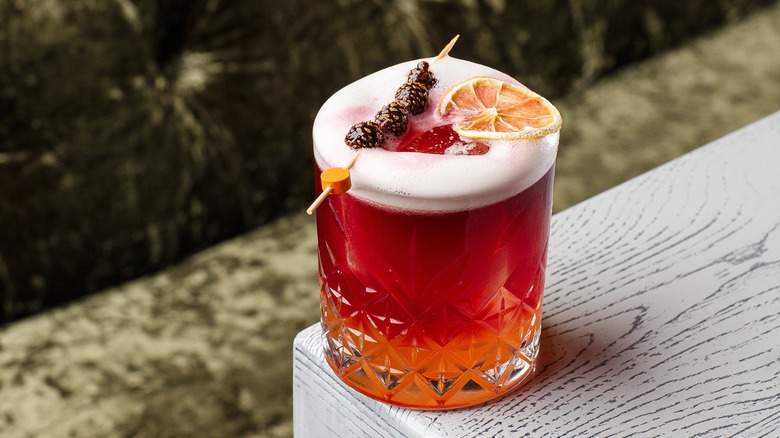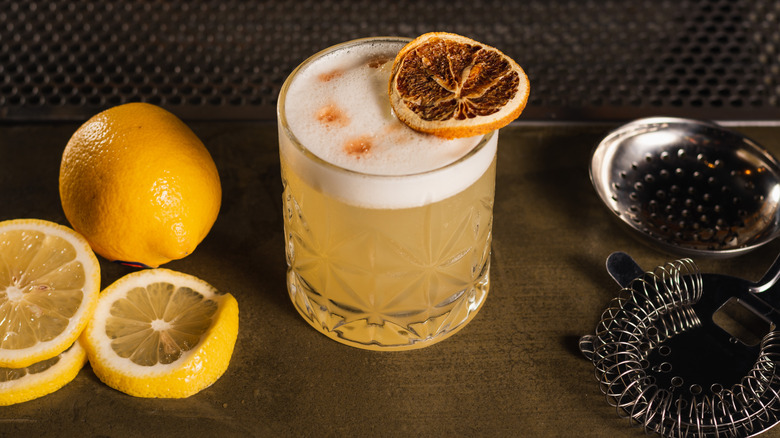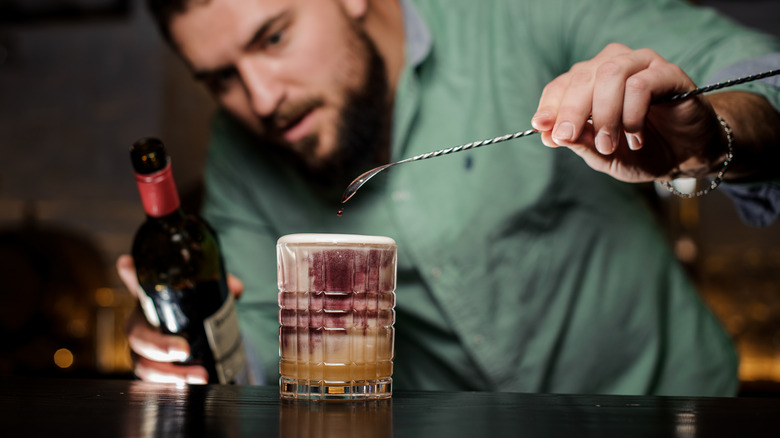What Makes A New York Sour Cocktail Different From A Whiskey Sour?
There are so many cocktails, it's hard to believe there was ever a time when they weren't quite a thing. However, according to NPR, it wasn't until the mid-to-late 19th century and early 20th century that these mixed drinks really took off. Looking back, that era is now referred to as the Golden Age of Cocktails, when the United States first discovered drinks like daiquiris, martinis, and Manhattans. In 1862, the father of American mixology, Jerry Thomas, wrote the first bartending guidebook, and his theatrical flair enshrined in text helped make mixed drinks more appealing.
From around this same time comes the first record of sour cocktails, according to Difford's Guide. A combination of citrus, liquor, sugar, and water, the sour seems to have come not from Americans but rather from the British Navy, who brought rum along to drink on long sea voyages and mixed it with lime juice in order to combat scurvy. Originally known as "grog," this concoction inspired the sour cocktail that first appeared in print on an 1856 menu. However, it was Jerry Thomas' 1862 tome "The Bartender's Guide" that actually listed out the earliest sour recipes: brandy sour, gin sour, and Santa Cruz (rum sour). The scene was thus set for the whiskey sour to emerge.
What a whiskey sour is
Knowing what sours generally are, it's not hard to guess what a whiskey sour specifically is. Add citrus like lemon juice, sugar (maybe in the form of simple syrup), and a whiskey together, and you've got yourself a whiskey sour, per VinePair. To prepare it, one must simply shake that combination with ice until it's cold, then remove the ice and shake it again to disperse the ingredients evenly. After, strain the drink into a glass, on the rocks, and decorate it with garnishes such as bitters, cherries, or lemons.
Back in the day, this simple formula was perhaps even more well-known than it is today. Difford's Guide notes that the first mention of whiskey sours comes from the Waukesha Plain Dealer, a religious Wisconsin newspaper. Therein, circa 1870, it's alluded to in a vague manner, implying that there was simply no explanation needed; everybody already knew what whiskey sours were. Other records from that same decade speak of it as if it were the quintessential American cocktail at the time.
Despite its simplicity, or because of it, the whiskey sour can easily be adapted. According to Arcadia Publishing, the Boston Sour, for example, adds egg white to the mix, creating a frothy top. Simply swapping out the liquor also mixes things up, like in the case of the amaretto sour with its amaretto liqueur. Then, there's the Daily Meal's own rhubarb whiskey sour recipe, as well. And who could forget the New York Sour?
What a New York Sour is
One slight change turns the Whiskey Sour into a much more autumnal cocktail. According to MasterClass, the New York Sour starts with classic whiskey or bourbon, sugar or simple syrup, and lemon or orange juice. Optionally, like the Boston Sour, you can also add an egg for a silky, velvety texture. The real kicker, though, is red wine, preferably something dry and fruity, like a shiraz or malbec. Ideally, the red wine should float atop the drink, achieved by pouring it down a bar spoon right above the surface. As explained by Liquor.com, that gives the drink its distinctive aroma and color. This only takes a handful of minutes to make; gather ingredients, mix everything but the wine in a cocktail shaker, strain it onto the rocks, add some redness, and garnish if you please.
According to Arcadia Publishing, this recipe was invented during the late 1870s by a Chicago bartender (who also claimed to have made the first Manhattan). Why is the beverage named after the Big Apple if it originated in the Windy City? That remains unclear, but the New York Sour has gone by several different names over the decades, such as the Continental Sour and Southern Whiskey Sour. Somehow or another, New York claimed it for its own, and the new moniker stuck.


